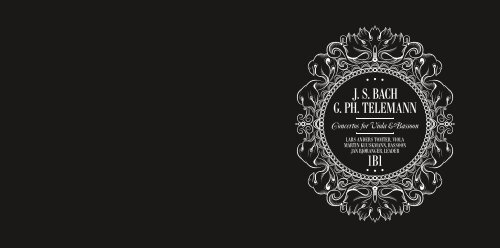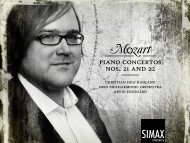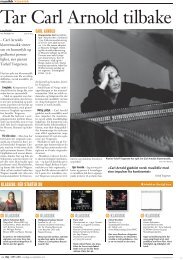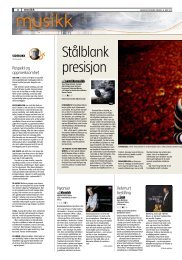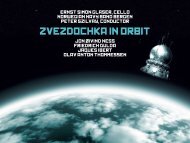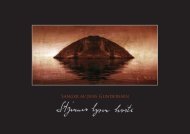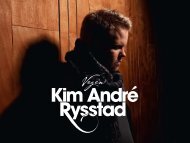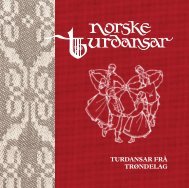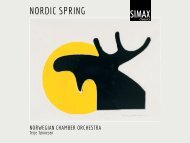J. S. BACH G. PH. TELEMANN 1B1 - Grappa Musikkforlag
J. S. BACH G. PH. TELEMANN 1B1 - Grappa Musikkforlag
J. S. BACH G. PH. TELEMANN 1B1 - Grappa Musikkforlag
You also want an ePaper? Increase the reach of your titles
YUMPU automatically turns print PDFs into web optimized ePapers that Google loves.
J. S. <strong>BACH</strong><br />
G. <strong>PH</strong>. <strong>TELEMANN</strong><br />
Concertos for Viola &Bassoon<br />
LARS ANDERS TOMTER, VIOLA<br />
MARTIN KUUSKMANN, BASSOON<br />
JAN BJØRANGER, LEADER<br />
<strong>1B1</strong>
JOHANN SEBASTIAN <strong>BACH</strong>:<br />
Concerto in E-flat Major for Viola, Strings and Basso Continuo .......................................... 16:18<br />
Reconstruction based on BWV 169, 49, 1053<br />
1 I Allegro 8:00<br />
2 II Siciliano 5:23<br />
3 III Allegro 5:25<br />
Concerto in D Minor for Bassoon, Strings and Basso Continuo .......................................... 12:02<br />
Reconstruction based on the fragment BWV 1059<br />
4 I Allegro 5:57<br />
5 II Adagio 2:46<br />
6 III Allegro 3:19<br />
Concerto in C Minor for Bassoon, Viola, Strings and Basso Continuo ................................... 14:05<br />
Reconstruction based on the version for Viola, Oboe, Strings and Basso Continuo, BWV 1060<br />
7 I Allegro 4:57<br />
8 II Adagio 5:44<br />
9 III Allegro 3:24<br />
2<br />
GEORG <strong>PH</strong>ILIPP <strong>TELEMANN</strong>:<br />
Concerto in G Major for Viola, Strings and Basso Continuo . . . . . . . . . . . . . . . . . . . . . . . . . . . . . . . . . . . . . . . . . . . . . .. 13:20<br />
10 I Largo 3:25<br />
11 II Allegro 2:40<br />
12 III Andante 3:47<br />
13 IV Presto 3:28<br />
Concerto in G Major for Viola, Bassoon, Strings and Basso Continuo . . . . . . . . . . . . . . . . . . . . . . . . . . . . . . . . . . . . 6:44<br />
14 I Avec douceur 2:33<br />
15 II Gay 1:34<br />
16 III Largo 1:05<br />
17 IV Vivement 1:32<br />
LARS ANDERS TOMTER, VIOLA<br />
MARTIN KUUSKMANN, BASSOON<br />
JAN BJØRANGER, LEADER<br />
<strong>1B1</strong><br />
3
In Norwegian folk music, a very strong and diverse tradition, every valley has its own eccentricities of<br />
rhythmic and tonal deviations. As these subtleties can hardly be written down, such traditions are very<br />
vulnerable, and could easily face extinction. There are furious traditionalists who want to preserve<br />
traditions vigorously, not polluting them with modern varieties.<br />
This is reminiscent of the prohibition on bringing horses to Iceland, in order to keep the Icelandic breed<br />
genetically clean. (It sounds a bit scary, but these are animals.) However, this raises the question: what is<br />
a living tradition? Is preservation the same as keeping alive, or is it the opposite, mummification? Are<br />
transformation, eternal metamorphosis and mutations the sign of a living tradition?<br />
I think that authenticity, a word much abused, is the main hallmark of any genuine art, whether it be<br />
folklore or any other. The term has also been used frequently in the context of historically correct<br />
interpretation of Baroque scores. This is a movement in music that I feel has, to some extent, concluded<br />
by now. It started as a bit of a revolution, rebelling against the establishment. The first examples would<br />
often sound odd, maybe interesting, often rather horrible both instrumentally and artistically, but<br />
definitely DIFFERENT.<br />
Within a few decades, however, the level has risen, as pure “differentness” or a dry scientific approach<br />
have been merged with intuition and true artistry. Today, I feel this has become common knowledge and<br />
an instinct we all can use in our own ways. Certainly, the legacy of Bach is such a universal one, that it –<br />
certainly highly Baroque – also stands out of time, open to many approaches. This is further enhanced by<br />
the fact that many of his manuscripts have disappeared, and thereby many prime sources have become<br />
lost in the shadows of history.<br />
Somehow, with Bach, this seems no obstacle: his music lends itself to many interpretations, many<br />
versions. He himself recycled his own music and that of others, and it feels strongly authentic to live on<br />
in that tradition with his music.<br />
This does not mean that anything goes: it has to be done with knowledge, skill and love. This recording<br />
has certainly has been made with love, and we hope the underlying skill and knowledge may pass muster.<br />
Lars Anders Tomter<br />
4<br />
CONCERTOS BY<br />
J.S. <strong>BACH</strong> AND<br />
G. <strong>PH</strong>. <strong>TELEMANN</strong><br />
by Malcolm MacDonald<br />
Between about 1738 and 1742, in Leipzig, Johann<br />
Sebastian Bach produced 14 concertos for one or<br />
more harpsichords, writing out seven of the eight<br />
concertos for solo harpsichord as a set. Quite<br />
apart from their very high musical quality, these<br />
were epoch-making works in the full meaning of<br />
the term, for they virtually established a genre that<br />
had hardly existed up to that time in Germany,<br />
though it would afterwards become increasingly<br />
popular: namely the solo keyboard concerto. As a<br />
group, in fact, these concertos of Bach could<br />
claim to be the most significant and imposing<br />
keyboard concertos before the piano concertos of<br />
Mozart. All the same, we are not speaking here of<br />
works that anticipate the Classical concerto: the<br />
5<br />
division between soloist and orchestra (in fact, in<br />
Bach’s case there was no orchestra – the solo<br />
instrument was part of a chamber consort) are<br />
not used to create dialogue or drama, nor do the<br />
soloist and the accompanying instruments have<br />
different and distinct thematic material. Instead<br />
they remain thoroughly Baroque in their<br />
interpretation of the concerto genre, the soloists<br />
participating in the consort with busy and often<br />
brilliant figuration and regularly coming to the<br />
fore. The works follow a three-movement pattern<br />
of extrovert outer movements and slow, rapt<br />
central ones, and there is no extremity of<br />
virtuosity in the solo parts.
And yet though it is as keyboard concertos that<br />
they have become best known, almost none of<br />
these started life in that genre. They were<br />
arrangements of concertos for other instruments<br />
that had been written at a decidedly earlier period,<br />
most likely when Bach was working in Weimar<br />
between 1708 and 1717 or in the years immediately<br />
following, when he was Kapellmeister to Prince<br />
Leopold of Cöthen. Their influential ‘new’ forms as<br />
a group of keyboard concertos were undoubtedly<br />
fashioned for performance at the meetings of the<br />
Collegium Musicum, the Leipzig concert society<br />
that Bach had directed (with a break in the late<br />
1730s) from 1729. But originally the works were not<br />
a ‘group’ at all, but simply a number of disparate<br />
concertos for a variety of solo instruments. On this<br />
CD we present speculative re-arrangements by<br />
Martin Kuuskmann and Lars Anders Tomter; not<br />
so much attempts at recreating the original forms<br />
of these concertos as to extend Bach’s practice to<br />
make them playable on other instruments – in this<br />
case, the viola and bassoon of these notable<br />
executants. These modern-day reconstructions,<br />
though not ‘authentic’ in a historical sense, are<br />
arguably as appropriate a treatment of the music<br />
as the composer’s own harpsichord<br />
transcriptions, and they give us the opportunity to<br />
hear Bach – and also Telemann – with new ears..<br />
J.S. Bach’s Concerto BWV 1053, played here as a<br />
concerto in E-flat for viola, strings and basso<br />
continuo, is based on the work best known as<br />
6<br />
Harpsichord Concerto No. 2 in E Major. Although<br />
versions of the first and second movements<br />
appear with organ obbligato in Bach’s Cantata No.<br />
169, Gott soll alein mein Herze haben, and a<br />
version of the third movement likewise in Cantata<br />
No. 49, Ich geh und suche mit Verlangen (securely<br />
dated to October and November of 1726<br />
respectively), the original of this work was almost<br />
certainly a now-lost concerto for oboe (or oboe<br />
d’amore) and orchestra from Bach’s Cöthen<br />
period. The viola makes a fine match for the oboe<br />
d’amore in terms of tessitura and tone-colour. This<br />
cheerful and good-humoured work opens with a<br />
lengthy da capo Allegro movement of the same<br />
kind as that with which Bach’s Violin Concerto in E<br />
Major opens, as do some of the Brandenburg<br />
Concertos: altogether a species of first movement<br />
that might have seemed rather vieux jeu by the<br />
end of the 1730s. The central portion of the<br />
movement is a continuous development of the<br />
type referred to in German as Fortspinnung<br />
(spinning forth: the technique – at which Bach<br />
was particularly gifted – of taking a motif and<br />
elaborating it into a complete musical structure<br />
by means of sequences, intervallic changes and<br />
repetitions). Here he uses the basic melody of the<br />
tutti’s ritornello and alternates it with several<br />
quasi-improvisational interjections from the<br />
soloist. There is a dramatic lunge to the minor and<br />
a pause before the reprise of the opening<br />
ritornello.<br />
The slow second movement is a delicious<br />
invention in the rhythm of a Siciliano, its lilting<br />
main theme announced by violins against<br />
chromatic harmony in the lower parts and then<br />
taken up and developed by the soloist at<br />
considerable length against chordal textures<br />
before returning to the opening tutti at the end of<br />
the movement. Like the first movement, the last is<br />
a three-part da capo Allegro, this time in an<br />
ebullient 3/8 jig time. In the developmental middle<br />
portion a rapid rising chromatic idea is used in<br />
sequences against some robust unison cadential<br />
gestures in the strings. The material of the<br />
opening ritornello melody begins to return a<br />
phrase or so at a time, and as in the first<br />
movement there is a powerful cadence into the<br />
minor mode before conjuring the final reprise of<br />
the boisterous ritornello.<br />
The Concerto in D Minor, BWV 1059, sometimes<br />
referred to as Harpsichord Concerto No. 8, is in<br />
one sense something that hardly exists: in fact, it<br />
is simply a nine-bar fragment – Bach seemingly<br />
gave it up having written out little more than an<br />
incipit of the first movement. However we find a<br />
complete movement (with organ obbligato) that<br />
begins identically, as the opening sinfonia of<br />
another of the church cantatas of 1726, namely<br />
No. 35, Geist und Seele wird verwirret. It has<br />
been theorized (with a fair degree of probability),<br />
that two other movements of that cantata – the<br />
first solo aria for alto, in siciliano rhythm, which<br />
7<br />
also has an organ obbligato, and a second<br />
sinfonia – represent the second and third<br />
movements of what would have become the<br />
Harpsichord Concerto BWV 1059, and<br />
furthermore that these three cantata movements<br />
are most probably all reworkings from a now-lost<br />
oboe concerto, like the original of BWV 1053.<br />
There are a number of reconstructions of the<br />
work – both of the intended Harpsichord<br />
Concerto (for example, by Igor Kipnis) and of the<br />
oboe original (for example, by Helmut<br />
Winschermann), dubbed BWV 1059 R. Because<br />
the original form of the slow movement is the<br />
most difficult to reconstruct from the cantata aria,<br />
some recordings have substituted a movement<br />
from an oboe concerto by Alessandro Marcello,<br />
but this is not done in the present version –<br />
indeed Martin Kuuskmann has said that it was<br />
because of the slow movement that he was<br />
especially drawn to BWV 1059, which is offered<br />
here in a version as a bassoon concerto. In this<br />
the original (oboe) solo part remains largely<br />
unchanged other than that it is played one octave<br />
lower. As Kuuskmann comments, ‘As the solo<br />
part moves independently from the ensemble’s I<br />
felt it was unnecessary to try to change things.<br />
Why disturb perfect music?’<br />
The Concerto in C Minor, BWV 1060 is best<br />
known as the first of Bach’s three concertos for<br />
two harpsichords and orchestra, but it has long
een held that the work’s original form was as a<br />
concerto for oboe and violin, and a scholarly<br />
reconstruction of this version has been published<br />
in the Neue Bach-Ausgabe as BWV 1060R. This<br />
in turn has been the basis for Kuuskmann and<br />
Tomter’s presentation of the work as a concerto<br />
for bassoon and viola, which gives new form to<br />
the beauty of Bach’s music. The work recalls<br />
especially the well-known Concerto for two<br />
violins, BWV 1043 and, as in that work, the writing<br />
is not especially weighted to instrumental<br />
virtuosity; instead Bach treats the concerto<br />
principle as a conversation of equal partners,<br />
blurring the distinction between solo and tutti.<br />
Cast once again in three movements, BWV 1060<br />
opens with an Allegro that is both rhythmically<br />
alert and undeniably tuneful. The strings give out<br />
the striking principal theme, but the attractive<br />
secondary subject and related motifs are<br />
announced by the bassoon and viola: indeed the<br />
soloists rarely have the first theme to themselves<br />
but engage in deft contrapuntal explorations<br />
around it as well as bursts of colourful bravura<br />
writing. This is particularly evident in the opening<br />
ritornello of the first movement, in which the<br />
soloists echo phrases as also in the first episode<br />
of the last movement, where the tutti strings<br />
repeat exactly phrases developed by the soloists.<br />
Martin Kuuskmann has explained his approach to<br />
adapting this movement for the bassoon as<br />
follows: ‘I ended up taking out most of the solo<br />
8<br />
lines in the first and third movements that were in<br />
unison with the first violins, instead playing such<br />
parts of the concerto along with the continuo,<br />
until the solo part set off independently again,<br />
thus following the Baroque bassoon concerto<br />
format. So, instead of having both soloists play<br />
along in the very beginning as people are use to<br />
hearing this famous work, [viola and bassoon] are<br />
instead playing along with each of [their]<br />
instrument families, etc’.<br />
The central Adagio is a movement of wonderful<br />
serenity, the bassoon having the long-breathed<br />
main theme at the outset, which is then taken<br />
over by the viola. Here the strings create a<br />
subdued background against which the soloists<br />
are able to spin an elegant and affecting<br />
contrapuntal web with their cantabile writing, the<br />
vertical alignment of their parts creating the<br />
essential harmonies. It is worth relaying Martin<br />
Kuuskmann’s comments on this movement also:<br />
‘Here, both solo bassoon and solo viola parts<br />
move independently from the orchestra; and<br />
although both parts are now most obviously<br />
played an octave lower from the original, the<br />
beautiful mix of the mellow timbres between the<br />
bassoon and viola and the rest of the ensemble<br />
brings forth the most beautiful and personal parts<br />
of this concerto […] it is truly as if sung by two<br />
human voices, as both instruments are now<br />
playing in a comfortable range for the human<br />
voice. To me personally, this movement is truly<br />
some of the most ingenious and incredible writing<br />
in the whole history of music -- the melody, the<br />
intertwining solo parts and the special aura this<br />
movement creates both musically and<br />
emotionally simply doesn't get any more perfect.’<br />
After this, the finale is typically busy and<br />
energetic, presenting the soloists with a whole<br />
range of challenges to their virtuoso technique.<br />
Although Bach was an enormously prolific<br />
composer, he – and just about everyone else –<br />
was outdone in this regard by Georg Philipp<br />
Telemann, whose total of works runs into the<br />
thousands. Perhaps one of the reasons<br />
Telemann’s Viola Concerto in G Major – the only<br />
such solo concerto he is known to have written –<br />
is so popular is the elegant manner in which it<br />
effects a junction between high Baroque style<br />
and the lighter style galant that began to overtake<br />
it towards the end of Telemann’s life, as a<br />
reaction to what had come to be seen as the<br />
ponderous, academic and old-fashioned<br />
Baroque. It might seem that very little common<br />
ground could be found between the two idioms,<br />
but in this delightful concerto Telemann (who<br />
was himself a violist) achieved a fusion of styles<br />
to create effective contrasts within a sense of<br />
overall unity. Unlike Bach’s preference in his<br />
concertos for the three-movement sonata da<br />
camera form, fast-slow-fast, Telemann casts his<br />
in the slow-fast-slow-fast form of the Baroque<br />
sonata da chiesa. A wistful opening Largo with<br />
9<br />
an unexpected little cadenza introduces a much<br />
lighter, gracefully melodic Allegro in the galant<br />
manner. The melancholic Andante, like the<br />
opening movement, features a small cadenza,<br />
and the concerto concludes with an ebullient<br />
Presto. Throughout, Telemann shows himself an<br />
adept in the distinctive tones and timbre of the<br />
viola from its lowest to its highest register.<br />
Telemann’s Concerto in G Major for two violas,<br />
strings and basso continuo bears the title<br />
‘Concert par Monsieur Telemann pour 2 violettes,<br />
2 violons, taille et basse’ – the use of the term<br />
‘violette’ for the viola is also found in Vivaldi, who<br />
referred to the instrument as the ‘Violette<br />
all’inglese’, though why it was regarded as a<br />
particularly English instrument is unknown.<br />
Tomter and Kuuskmann here offer a version for<br />
viola and bassoon of this diverting little concerto.<br />
This again is in four-movement form, though in<br />
this case the opening movement, designated<br />
Avec douceur, is more like a formal overture,<br />
with the soloists often subsumed into the<br />
orchestral ensemble. The second movement,<br />
marked Gay, is an exuberant dance in which the<br />
soloists come more to the fore, alternating with<br />
robust ensemble writing. The Largo third<br />
movement is solemnly expressive and<br />
emotionally poised, acting as a slow introduction<br />
to the finale, Vivement, which is again a jocund<br />
dance-movement requiring considerable bravura<br />
from the soloists.
Photo: Nicki Twang<br />
10<br />
Lars Anders Tomter (born in 1959) is one of<br />
today's outstanding and prominent violists. He<br />
studied both viola and violin with Leif Jørgensen<br />
at the Oslo Music Conservatory and the<br />
Norwegian Academy of Music, and gave his<br />
debut on both instruments at the age of 17. After<br />
continuing his studies with Professor Max Rostal<br />
and Sándor Vegh, he was awarded a special<br />
prize for his interpretation of Bartók's Viola<br />
Concerto at the International Viola Competition in<br />
Budapest in 1984, and he won the Maurice Vieux<br />
International Competition in Lille in 1986. Since<br />
then his appearances as a viola soloist have been<br />
greeted with the highest public and critical<br />
acclaim throughout the world.<br />
Tomter has performed with orchestras such as<br />
the Royal Philharmonic, BBC Symphony, BBC<br />
Scottish Symphony, Academy of St. Martin in the<br />
Fields, City of Birmingham Symphony, Czech<br />
Philharmonic, Dutch Radio Philharmonic,<br />
Frankfurt Radio Symphony, the Hungarian State<br />
Philharmonic, KBS Symphony, Oslo Philharmonic,<br />
Bergen Philharmonic, Danish National Radio and<br />
Swedish Radio Symphonies. Conductors he has<br />
worked with include Vladimir Ashkenazy, Dennis<br />
Russell Davies, Daniele Gatti, Manfred Honeck,<br />
Arvid Jansons, Okko Kamu, Dmitri Kitaenko, Ken<br />
Ichiro Kobayashi, Krzysztof Penderecki, Ulf<br />
Schirmer, Muhai Tang, Yan Pascal Tortelier, and<br />
Hans Vonk.<br />
11<br />
He is a regular guest at festivals like<br />
Schleswig-Holstein, Lockenhaus, Kissingen<br />
Summer, BBC Proms, Mondseetage, Styriarte, as<br />
well as a number of Scandinavian festivals. In<br />
addition, he is artistic director of the Norwegian<br />
Risør Chamber Music Festival. Lars Anders<br />
Tomter is a professor at the Norwegian Academy<br />
of Music. He plays a Gasparo da Salò viola dated<br />
from 1590.<br />
www.lars-tomter.no
Photo: Karl J. Kaul<br />
05 12<br />
Estonian-born bassoon virtuoso Martin<br />
Kuuskmann's charismatic and entertaining<br />
performances throughout the world have earned<br />
him repute as one of the leading solo instrumentalists.<br />
The New York Times praised Kuuskmann’s<br />
playing thus: “dynamic…amazing…Kuuskmann<br />
played stunningly…” and in 2008 he received a<br />
Grammy Nomination for his recording of David<br />
Chesky’s Bassoon Concerto.<br />
As a strong advocate for new music, Kuuskmann<br />
has premiered eight bassoon concertos written<br />
especially for him by Christopher Theofanidis,<br />
David Chesky, Erkki-Sven Tüür, Eino Tamberg, Tõnu<br />
Kõrvits, Gregor Huebner, Gene Pritsker and<br />
Charles Coleman, and is working on upcoming<br />
concertos by Miguel Kertsman; his collaboration<br />
with composers including Daniel Schnyder, Helena<br />
Tulve and jazz icon John Patitucci have lead to<br />
numerous new solo works from bassoon and<br />
string quartet to bassoon and electronics.<br />
Kuuskmann has performed Michael Daugherty's<br />
madcap concerto "Dead Elvis" across the world<br />
nearly 50 times.<br />
A sought-after soloist, Kuuskmann has been<br />
invited by the Orchestre de la Suisse Romande,<br />
New York Philharmonic, Estonian National<br />
Symphony Orchestra, the Indianapolis Symphony<br />
Orchestra, Macao Orchestra, Nordic Symphony<br />
Orchestra, Riga Sinfonietta and Grazioso Chamber<br />
Orchestra of Hungarian National Philharmonic,<br />
among others. A frequent guest at festivals,<br />
Kuuskmann appears regularly at the Järvi Summer<br />
05 13<br />
Festival, Bremen Musikfest, as well as Landsberg,<br />
Kuhmo, Gaia, Umeå, Menuhin Festival Gstaad, to<br />
name a few. Kuuskmann is a founding member and<br />
solo bassoonist of the New York City based<br />
Absolute Ensemble.<br />
A graduate of the Yale and the Manhattan Schools<br />
of Music, Kuuskmann's mentors include Stephen<br />
Maxym, Frank Morelli, Ilmar Aasmets and Rufus<br />
Olivier. An avid educator, Kuuskmann teaches at<br />
the Manhattan School of Music and the Cornish<br />
College of Arts, serves as the woodwind coach of<br />
the Baltic Youth Philharmonic and teaches<br />
regularly at the Arosa Master Classes in<br />
Switzerland, among others. An artist of Moosmann<br />
bassoons and Miller Marketing Company, Martin<br />
Kuuskmann plays on the Moosmann 222E model<br />
and on reeds by KJI, Gumin and Légere.<br />
www.martinkuuskmann.com
Photo: Peter Adamik<br />
05 14<br />
Jan Bjøranger (born in 1968) is the founder and<br />
artistic director of <strong>1B1</strong> (Ensemble Bjergsted 1).<br />
The idea to develop a strong musical<br />
infrastructure in the region, based on the<br />
founding of a new, high-quality ensemble, has<br />
grown in parallel with the understanding of the<br />
opportunities and challenges the environment for<br />
music and art is facing in the Southwestern<br />
region of Norway.<br />
As professor and head of the string department<br />
at the University of Stavanger, Bjøranger<br />
occupies a prominent position among Norwegian<br />
music educators, as well as pursuing a very<br />
active career as a performing artist. Throughout<br />
his career, Jan Bjøranger has shown a strong<br />
instinct as a musical entrepreneur. He was the<br />
artistic director of the Umeå International<br />
Chamber Music Festival in Sweden for six years,<br />
as well as the founder of the KGA Festival in<br />
Norway. He says that his work to establish EnB1<br />
triggers both his musical skills as well as the<br />
entrepreneur and educator in him.<br />
Bjøranger is a sought-after leader for ensembles<br />
and orchestras in Europe, including Camerata<br />
Salzburg, the Scottish Chamber Orchestra,<br />
Gothenburg Symphony, Danish Radio Symphony<br />
Orchestra, as well as the Trondheim Soloists, the<br />
Norwegian Chamber Orchestra and the Danish<br />
National Chamber Orchestra. As a soloist and<br />
chamber musician, Jan Bjøranger has performed<br />
in several countries in Europe and overseas.<br />
05 15<br />
Jan Bjøranger has participated in a great number<br />
of recordings, mostly as leader or part of<br />
ensembles, but also as a soloist, for labels like<br />
Phillips, Sony, CcnC, Chandos, EMI, Simax, Lynor,<br />
and Intim Musik. <strong>1B1</strong> aims to perform the music<br />
of our own time. Jan Bjøranger’s strong working<br />
relationships with composers like Arvo Pärt,<br />
Steve Reich, James MacMillan, Mark Anthony<br />
Turnage, Piers Hellawell, Daniel Schnyder and<br />
Gija Kancheli, will contribute much to this goal.
Photo: Peter Adamik<br />
05 16<br />
<strong>1B1</strong>* is a progressive string ensemble founded on<br />
the occasion of Stavanger's year of being<br />
European Cultural Capital in 2008. It unites<br />
musicians teaching at the University of<br />
Stavanger, their most accomplished students,<br />
and members of the distinguished Stavanger<br />
Symphony Orchestra. Its founder and artistic<br />
leader is violinist Jan Bjøranger.<br />
<strong>1B1</strong> produces between two and four events<br />
annually, its goal being to perform the best music<br />
available - especially when it is not universally<br />
well-known - for any music-loving audience, on<br />
any available stage. It considers itself an<br />
educational enterprise both for players and<br />
audiences in the best possible sense - the joy of<br />
discovery, the accomplishments of cooperation<br />
and the bonds formed by that ancient and<br />
ever-evolving art form, music, being the guiding<br />
elements of all its activities. With its joint<br />
educational program in Stavanger and<br />
Kristiansand, <strong>1B1</strong> also seeks to unify the region<br />
and add to its cultural profile in Norway and<br />
throughout the musical world.<br />
To achieve these goals, in its short existence <strong>1B1</strong><br />
has already collaborated with such outstanding<br />
performers and composers as Arvo Pärt,<br />
Clemens Hagen, Benjamin Schmid, Steve Reich,<br />
Tonu Kaljuste and Lars Anders Tomter - names<br />
that illustrate and guarantee the high artistic level<br />
that <strong>1B1</strong> strives for, and achieves.<br />
05 17<br />
You will hear the goals and mission of <strong>1B1</strong><br />
epitomized in the present recordings, which<br />
document a program performed by <strong>1B1</strong> in<br />
September 2012 for the opening of the new<br />
concert hall in Stavanger - a befitting occasion<br />
for <strong>1B1</strong>'s debut album.<br />
*Jan Bjøranger explains the name: “<strong>1B1</strong> started<br />
out as EnB1, an abbreviation for "Ensemble<br />
Bjergsted 1". EnB1 was originally based in<br />
Bjergsted (Stavanger's unique centre for music<br />
and dance, containing concert halls, an<br />
educational environment and a beautiful park,<br />
just a five-minute walk from the city centre), so<br />
we decided to use that address as the basis for<br />
our name. Subsequently, it was not only for<br />
reasons of graphic design that we decided that<br />
instead of "En" we wanted to use the number 1<br />
(En = 1 in Norwegian) twice in the name of our<br />
ensemble: <strong>1B1</strong>. Our vision now includes a bigger<br />
geographic focus than when we got started, and<br />
"wanting to be one" is a good signal and symbol<br />
for this. Since unifying is the main concept and<br />
focus of the group and reaching the top is always<br />
easier if forces are joined, "want to be one"<br />
contains all the possible ambitions growing out of<br />
our address, manifested in our name - <strong>1B1</strong>.”<br />
www.1b1.no
18<br />
Recorded 18-22 January 2012 in Tanager Church, Sola, Norway<br />
Producer, engineer and editor: Sean Lewis<br />
All reconstructions by Lars Anders Tomter and Martin Kuuskmann<br />
Liner notes: Malcom MacDonald<br />
Editorial assistance: Alexa Nieschlag<br />
Design: Martin Kvamme<br />
Released with support from Fond for lyd og bilde, Tanager kirke,<br />
Norges musikkhøgskole, Universitetet i Stavanger, Rica Hotels<br />
π&© 2012 <strong>Grappa</strong> <strong>Musikkforlag</strong> AS<br />
All trademarks and logos are protected. All rights of the<br />
producer and of the owner of the work reproduced reserved.<br />
Unauthorized copying, hiring, lending, public performance<br />
and broadcasting of this record prohibited.<br />
ISRC: NOFZS1326010-170 · PSC1326 Stereo<br />
19


